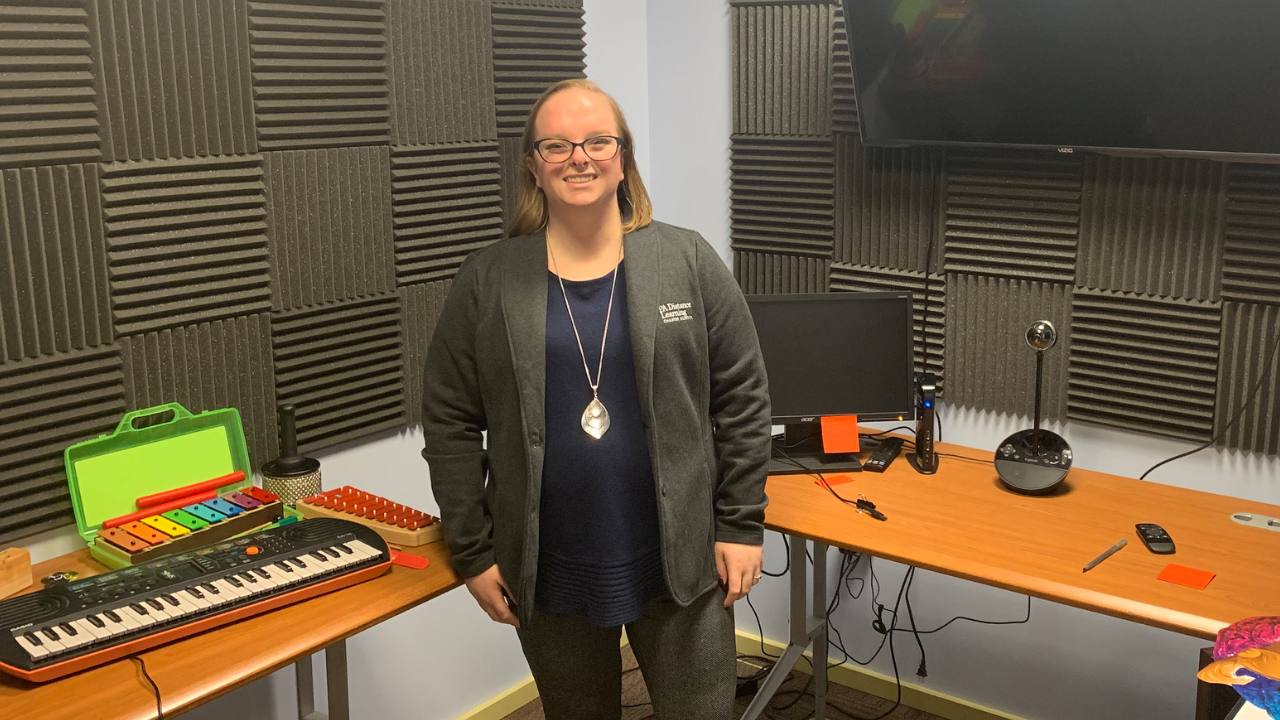Mrs. Elisa Carpenter Teaches Music Virtually to Elementary Students

As early as she can remember, PA Distance music teacher, Mrs. Elisa Carpenter, had always wanted to be a teacher. Growing up, she had first-hand knowledge of what it was like working with children because her mother was (and still is) a special education teacher. This exposure and desire to help people led her to pursue teaching as a profession.
“It’s always been about serving people rather than just a job,” she explained.
Mrs. Carpenter began her higher education at Duquesne University in Pittsburgh, PA, where she received a Bachelor of Science in Music Education K-12th grade with a Minor in Piano Performance.
During her time at Duquesne, she served as the Service Learning Liaison between the Mary Pappert School of Music and the Providence Family Support Center in Pittsburgh.
“My freshman year, I was very interested in service-learning and reaching out to those who were under-served and didn’t have access to the creative arts, like music,” she explained.
Before graduating from Duquesne, she was already getting valuable experience teaching. Mrs. Carpenter explained that her learning experiences in college molded her into the person and teacher she is today.
“While in school, I began teaching a Pre-K and Kindergarten class, and it was one of those experiences that taught me what kind of teacher I wanted to be and what kind of leader I wanted to be in the music world,” she said.
At PA Distance, Mrs. Carpenter teaches music to 2nd, 4th, 6th graders. The curriculum, she explained, is research-based, systematic, and foundational in all of the key developmental areas that students need in a very individualized and group-based way. Music touches on all learning domains, including the psychomotor domain, the cognitive domain, and in particular and significant ways, the affective domain, including music appreciation and sensitivity.
“In our elementary classes, we teach the same things that you would see in a music class in a brick a mortar school, which includes reading, writing, and composing with music,” she explained.
“We listen to folk songs, play games, have group work, projects, and learn about the history of music,” Mrs. Carpenter added.
She does most of her teaching in a special sound-proof room (pictured above) complete with a large TV mounted on the wall, where she can view her students, a wide-angle camera, so her students can see her, and a menagerie of teaching tools.
“Things can get a little loud, and some of my students get excited, so this room makes it easy to teach without any inhibitions,” she said with a laugh.
All students are given musical instruments to learn and are sent to their houses before the school year begins. In 2nd grade, students get finger cymbals and woodblocks, geared towards rhythmic patterns. In 4th grade, students get resonator bells, and rhythm sticks to read music and play each instrument along to it. And finally, in 6th grade, students receive a Casio keyboard complete with white and black keys and rhythm buttons.
.png)
“A lot of my students independently play instruments. Some play the piano or the guitar, and some play for their church hand-bell choir or participate in dance classes outside of PA Distance,” Mrs. Carpenter explained.
Mrs. Carpenter isn’t blind to the skepticism that often attaches itself to cyber schools. More often than not, she gets questions from friends, family, and strangers about what it’s like to teach music at a cyber school. One question, in particular, is more prevalent than others: “How do you teach music online?”
“It’s my favorite question because I say, just the same as any other teacher at any other school,” Mrs. Carpenter said.
“I can still sing, I can still play instruments, I can still do worksheets, I can take the time to have the kids play, they can work in groups, etc.,” she explained. “All the physical actions and activities that need to happen still happen.”
She thinks PA Distance is unique in many ways, but especially when it comes to the manner in which she teaches.
“The benefit of a cyber school is, I can get answers twice as fast, give immediate feedback, and have them try it again all within 30 seconds,” she explained.
She added, “They get responses back from me immediately. It creates this environment where the learning is continuous. We can address questions right away and work with kids one-on-one in real-time, right away, just like you see in a brick-and-mortar.”
Mrs. Carpenter, and her colleague, Mr. Hart, host two virtual concerts each school year for grades K-12. During the spring and winter concerts, each participating student showcases their talents with a variety of songs, dances, poems, and other festive mediums.
After teaching for five years, she still agrees that PA Distance is the perfect fit for her.
“I chose PA Distance because of its mission. It 100% lined up with my goals and where I wanted to improve,” Mrs. Carpenter said “Music is not just an outlet for me but for other people as well. All kids should have access to music.”
{% video_player "embed_player" overrideable=False, type='scriptV4', hide_playlist=True, viral_sharing=False, embed_button=False, autoplay=False, hidden_controls=False, loop=False, muted=False, width='1920', height='1080', player_id='29282431015', style='' %}

